#enrichment for my pet roaches. you know.
Explore tagged Tumblr posts
Text
"insects are such boring pets, they don't do anything!"
Wrong. My dubia roaches are precious, and actually quite intelligent. One of them has learned to get out of the terrarium, some how (it is always the same one, as she's the only one who has developed (flightless) wings) and has learned to crawl to the top shelf and get my attention by scuttling about on the tinfoil bases the plants up there sit in to catch water. It is around the same time several nights in a row, to tell me that the colony would like some new repashy food please. Her big bulky body makes a very distinct sound on the metal, and she's very easy to catch, often just crawling into my hand unless i scare her. She returns back to the tank as soon as I put my hand in there. And then i add more of their food mix and they ALL scurry out of hiding and go ham over food.
My pet roach is learning to Pavlov me into giving them food.
#insects#Roaches#dubia roach#terrarium#bioactive#they LOVE repashy detritivore premix#theyll eat it dry#i often just sprinkle some in then water the whole set up and they can scavenge and scrounge for the Bits#enrichment for my pet roaches. you know.#they are so so cute i love them#excited cause more of them should be reaching full maturity soon and i wanna see who grows full wings to more easily sex them
29 notes
·
View notes
Text
Blog Prompt #1
I live in a zoo. We do not have government funding, cotton candy and pretzel stands, or a sign outside welcoming visitors to gawk at the animals on display. We do not have any particularly large or exotic animals. We do not carefully replicate the native environments of these animals over acres of carefully manicures land. We do, however, have 23 animals living under the same roof.
(3/23) Starting with our rowdiest exhibit: three adult dogs. Pawsta, a golden retriever overwhelming in his cuteness and ability to rupture your eardrums with his barks ; Princess, an protective and territorial blue pit bull; and G*psy (I prefer to call her dipstick), an 18 year old dust bunny of a dog that was named after a slur by my landlords ex- husband. These animals are a part of our facilities petting zoo, as they love (though require might be a better word) attention.
(7/23) Our next exhibit is my personal favorite: the four cats. The oldest and wisest of the cats in Saphira. She is a skittish and obese short haired tabby who is likely smarter than us all. The next oldest is Bum (short for Solembum). Emetophobics beware, because this long haired tuxedo loves to eat too quickly and throw up on any available surface. The naughty middle child of the group is another short haired tabby named Momo. Her hobbies include drinking from the toilet, opening closed doors, and demanding cuddles. The youngest child has a special place in my heart. This black short haired kitten is named Irradiated Cockroach a.k.a. Radroach a.k.a. Roachie a.k.a. Roach. I bought this affectionate kitten when I moved up here from Baltimore. She is named after an enemy in my favorite post-apocalyptic video game franchise: Fallout.
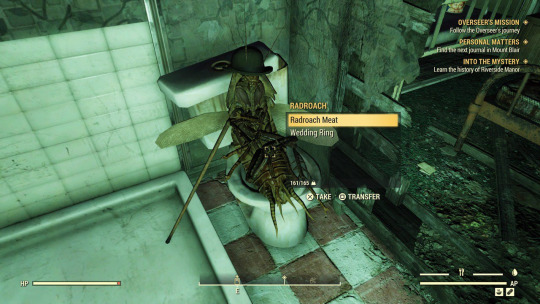
Roach is loud and codependent and I would gladly take a bullet for her.
(13/23) We also house 6 ferrets. They are in an enclosure that is larger than most dorm rooms. They are named River, Scooby, Mink, Sea, Granger, and Luna. Did you know that ferrets can clear their entire digestive tract in 3 hours and will die without 24/7 access to kibble? I sure didn't until I had to house sit and take care of them.
(15/23) There are two sisters at the house. They are a pair of elderly rats names Mars and Po. They are a vital component of the house as they eat our fruit and veggie scraps as well as our leftover toilet paper rolls. One of them recently had surgery and made sure to let her anger over the situation be known. As the Smashing Pumpkins once eloquently stated: "Despite all my rage, I am still just a rat in a cage".
(18/23) There are three frogs that do not have names. It is also likely that I do not know their names. I also do not know what kinds of frogs they are, but they live in the same humid enclosure and eat crickets.
(19/23) Our most elusive animal is a terrapin. One of her favorite tricks is escaping her enclosure and being found hours later across the house in the kitchen.
(20/23) Other than the aptly name Roach, I have contributed one other animal to this zoo. He is a juvenile pink toed tarantula. He accompanied me on my trip from Maryland to Massachusetts. He was a fantastic travel companion on my road trip. Since he has shjown himself to be responsible in the past, he was in charge of the music, the snacks, and the directions.
(23/23) Our final exhibit is three ethically captured graduate students. My two roommates and I thrive off of simple enrichment (watching television), regular walks (cardio at the local YMCA), and balanced meals (sometimes salads, sometimes a plate of pizza rolls). Despite requiring separate enclosures for nesting and sleeping, we all get along quite well.
Tickets to this zoo are available upon request.
1 note
·
View note
Note
Hello! Sorry if you’ve answered this before! Do you have a starling food mix recipe you’re fond of using? There are so many different ones out there! Having input from someone actively keeping starlings would be super helpful!
I don't think I've posted my recipe before actually. :) My personal recipe comes from a bit of testing to find one that fit the nutritional requirements of my birds, as one of the previous cat food bases ended up nearly giving Ziggy hyperkeratosis. Thankfully I noticed early and made the switch and he is fine now. The food I settled on happens to be in swallowable pieces so I don't have to put them in the food processor, which is a bonus! Please note this is for adult starlings, not juveniles.
My personal adult starling diet recipe:
Dry mix:
- 1 cup Rachel Ray Nutrish for cats chicken and brown rice (note: do not buy the grain free kind)
- 1/4 cup chicken layer crumble
- 1 tbsp whole egg powder
Offer at all times in cage.
Offer separately (daily if possible):
~ 1 tbsp black soldier fly larvae (natural dried + gut loaded) daily, on a terra cotta dish for beak trimming or sprinkled in foraging toy
~ 1 tbsp fruit or unsweetened applesauce (pretty much any fruit, no pits or seeds, also it will get everywhere so be prepared for that)
- Small amount of misc. human foods such as cooked chicken breast, cooked turkey, bread crust, chopped nuts, broccoli florets, leafy greens such as beet tops and celery tops, etc. Generally if it is listed on parrot websites as "safe for birds" it will be safe for starlings, but use your own personal judgement, and don't offer them anything seasoned (especially salted stuff.)
- If you can want to offer live insects for enrichment, feeder crickets or dubia roaches from pet stores are generally safe and good for your bird.
Hope this helps. Let me know if you have any other questions!
#birds#pet bird#birb#birblr#starling#european starling#sturnus vulgaris#food#diet#resources#resource#ask
16 notes
·
View notes
Text
Insect Enrichment
It’s relatively common knowledge that vertebrate pets require environmental stimulation in order to stay happy and healthy. When it comes to arthropods, however, few people bother to provide enrichment, either because they feel it unnecessary, or, as I felt, just don’t know how exactly to approach it. In keeping Guyana spotted cockroaches (aka dubia roaches, Blaptica dubia) over the last year, I’ve found them to be surprisingly complex in their behavior, and have tested several types of enrichment with them that I feel I could share to help others in the same position as I was.
First, for those who don’t know already, what is behavioral enrichment, and why is it important? Enrichment refers to any practice that seeks to provide animals with stimuli that will encourage them to engage in natural behaviors in order to maintain mental and physical health in captivity. This results in longer, healthier, and happier lives for the animals. For more intelligent animals such as mammals and birds, this often takes the form of toys and food puzzles, which is what many people immediately jump to when they hear the word. However, for arthropods, enrichment must take much more diverse and subtle forms.
Enclosure Design and Population
The first and easiest form of insect enrichment is enclosure design, which can be easily and effectively applied to any species with just a bit of research. While needs such as water and food can easily be met in an empty plastic container, and may keep your insects alive and well, going a little bit deeper and researching your species’ natural environment can give you big head start before even trying more complicated methods of enrichment. The first piece to consider is substrate. While many species don’t need a substrate, many others find it a necessity. Different species will likely have different substrate needs, but most have easy to find info online. Substrate is an important and easy way to allow burrowing insects access to their most common natural behavior. Another factor important for nearly all insects is some form of shelter. Whether it be a piece of bark or upturned egg carton, allowing your insects to hide from view will greatly reduce the stress of captivity for them. Many insects also have more specific environmental needs. Arboreal insects will likely appreciate the ability to climb objects within the enclosure, while other insects may prefer to stay grounded. Do research into your species for setting up their enclosure. These needs should be attended to first and foremost, before any more intricate enrichment.
Despite the common notion of insects (besides ants and bees) as unsocial creatures, many have complex and interesting social interactions in nature. In caring for my roaches, I’ve found it interesting to observe their behaviors and have even felt that some have personalities (one of my males, who’s wings never fully formed, is amusingly the most aggressive, chasing the other males around). I think it is important to allow species that commonly live in groups to interact with their own species in order to stimulate their natural territorial (and in some cases, hierarchical) interactions. However, some species are solitary, notably mantids, and this should be accounted for too. Choosing how many of a species should go in an enclosure is as fundamental as the enclosure itself, and integral to overall welfare.
This post is already getting a bit long, so I’ve decided to cut it for your sake. I’ve got a bit more to say though. Click ‘keep reading’ for the rest!
Novelty
Novelty is an important concept in animal enrichment. Changing features in an animal’s enclosure or care forces them to relearn actions and break habits. This keeps them mentally and physically active, and can easily be applied to most any species, vertebrate or invertebrate. The easiest way to apply the concept of novelty is simply changing the locations of objects in the enclosure from time to time. By moving shelter, water, or food, your insects will have to learn the new locations of these objects. Don’t move too much at one time though! Many insects will get stressed if you completely upturn their enclosure each time you want to give them enrichment. Simply move small pieces at a time to encourage exploration without causing too much stress. The easiest (and from what I have seen, most effective) thing to move is food. Don’t just put the food in one place; moving it around the enclosure (or even hiding it under something) can encourage investigation and foraging, mimicking skills necessary in the wild. You can add structures to climb and put food on to of that even. I recently put a cardboard tube in with my roaches, with food in the top. Though at first they were confused, they eventually found their way up! Though you may worry that your insects may be unable to find their food in its new location, don’t worry. Most insects have very keen senses and will likely find it eventually, though you should consider whether your location is appropriate for your specific species.
Variation of Food and Scents
A more specific technique derived from novelty is varying food. Many herbivorous and omnivorous species, such as roaches, will benefit greatly from semi-random variation of food. By changing what type of food you give them, you will keep your insects engaged in feeding, as they will not become disinterested with any one food. Different types vegetables contain different nutrients, and switching up which you use allows your insects to select the exact ones they need to stay physically healthy. Most insects also have highly sensitive antennae, which give them a great sense of smell. Varying food will give the enclosure different aromas depending on what is fed, giving the insects a reason to use their senses to investigate. Scents can also be added from non-food sources, although you should be careful to research any possible pesticidal characteristics of anything you add to the enclosure. I have personally experimented with occasionally adding herbs to my roach enclosure, with great success, as the roaches quickly become excited towards the strong scents. Simply varying food and scents in an enclosure helps to keep insects active and curious, resulting in longer, healthier lives.
To Conclude
At this point, it should be clear that enrichment exists for more than just vertebrates, and is actually very easy to provide with just a little research and effort. I really hope that some of the people who read this find it interesting and helpful, and I hope that this information will be useful in caring for insects. I know many people don’t really like arthropods, but I’ve found them to be fun and engaging pets, and highly recommend them. Thank you for reading all the way through, it means a lot. Best wishes in future invertebrate care, and feel free to ask any questions you have!
692 notes
·
View notes
Text
Why Enrichment Matters, and Why Improvement Never Ends
Animal enrichment is a never-ending process of learning and always, forever striving to improve.
I haven’t said much about the pair of button quail we adopted earlier this year, but they’re really something special. I’ve never owned birds before them, but I had done a lot of research into quail off and on and I’ve always obsessed over birds in general, but nothing else is like actually owning one in my own house. I’ve learned so much from just observing them and making small changes to their environment and care, and it has benefited them so much.
Wasabi (rooster) and Mushroom (hen) were hatched and reared by a local couple to us, along with several other roosters and hens that they hatched at the same time. Not realizing until later that button quail, especially roosters, are territorial and do best in pairs, they were looking to adopt out most of their quail to good homes, and we decided to adopt two of them.
Being hand-reared, they aren’t as horrifically skittish as I’ve heard other button quail to be (I’ve heard stories of some that are so nervous they bolt upwards to the point of hurting themselves if anyone so much as comes near their enclosure, and they remain Extremely Stressed after any enclosure maintenance!!) but they were NOT, and are not, handleable. Which was fine by me, I never expected them to be cuddly, but it was a little disheartening that they didn’t seem as relaxed as I wish they would be. Even after they calmed down and adjusted to being together (they were both housed separately before, but quickly bonded and have never had any issues) and being in a new environment, they would spend a lot of their time awake pacing and pecking at the walls, acting agitated even though they had room to move and plenty of food/water. I even gave them treats, which would calm them down for a short period of time, but soon after they would be back to pacing.
We have now had the pair for almost five months now, and so much has changed. I don’t think my initial care of them was ever BAD, per se...they’re still in the same enclosure they started in, with the same wood decor and they get the same treats...but all of the small changes I made over time have definitely made a difference.
After spending so much time watching their interactions and behaviors, I managed to test many different ideas and slowly alter and Improve their living environment and husbandry to what it is now.
This was their original set up right before I got them:
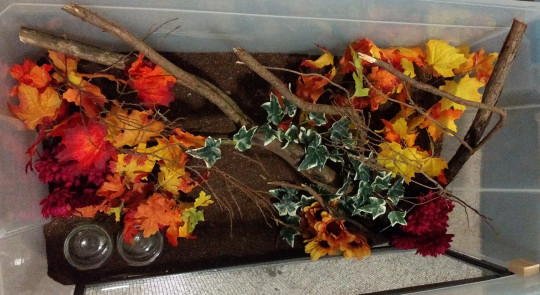
It’s not BAD, not at all! But it really wasn’t best for the birds. This was my first time owning any bird, let alone a ground-dwelling bird like button quail, so using my research and some assumptions I tried to come up with a set up that might make them feel more comfortable while also giving them space to perform natural behaviors. The substrate was a modified mix of my tarantula substrate (topsoil, coco coir, vermiculite, and sand) with extra soil for dust bathing. I used half-pint mason jars as food and water dishes, and (not shown here) mason jar lids for oyster shell and grit.
It was alright. There was some cover for them to duck under, and plenty of open space too, but I quickly realized it wasn’t nearly enough cover to make them feel Secure, and the semi-transparent sides may have been contributing to their pacing.
Over the weeks, I experimented...
I mixed up the wood placement, substrate choices (turns out 100% soil isn’t best, actually! They LOVE soil/sand for dust bathing, but it’s better as one specific corner, and pure RINSED sand is their favorite!), messed around with adding cover and changing foliage color/types, I tried growing live plants early on (that was a huge failure, by the way), experimented with different types of treats and forages (millets, roaches, and black soldier fly larvae are big favorites!!!), and learned a lot from watching their behaviors.
Over time, they grew bolder, and CALMER.
Here is their enclosure today, for reference:
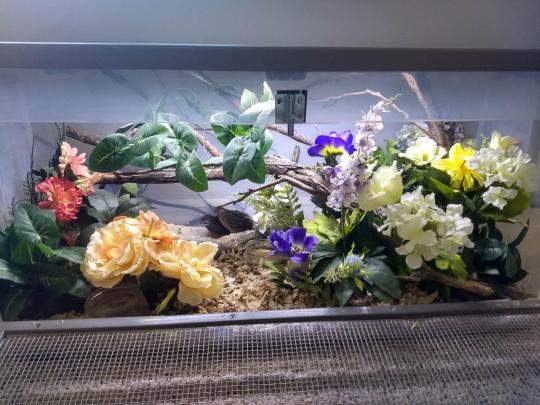
It’s been a while since I last switched them over to their newest substrate (mostly soft paper bedding with a corner of play sand) and decor, and I haven’t noticed ANY pecking or pacing. Sometimes Mushy will pace the front of the enclosure and peer through the crack in the door, but she never pecks like she used to. They don’t even crow as much these days...they both have a wide variety of beeps, songs, and crows, but they only make a huge fuss if they’re low on water or food. In a way, they’ve trained me to keep all of their resources in tip-top condition and I’m convinced that soon they’ll figure out how to beg for treats, too!! Every time I open the door (to spot clean, replace water/food, remove eggs, etc.) I ALWAYS scatter healthy treats or leave a dish of insects for them, and it GREATLY reduces maintenance-associated stress. In the past week, she won’t even run from my hands!! (Well okay, today she ran, but I also had to remove her Secret Egg Stash and a lot of bedding from the sand so the movement set her off, but still, usually she’s good) Most of the time she waits for the doors to close before she dives for treats, but a couple times now she will wait for me to put it down in front of her, and will even eat with the door open and me sitting right there!! She’s still not perfect (again, today she was more antsy, but I don’t blame her) but she, and Bibi, come such a long way.
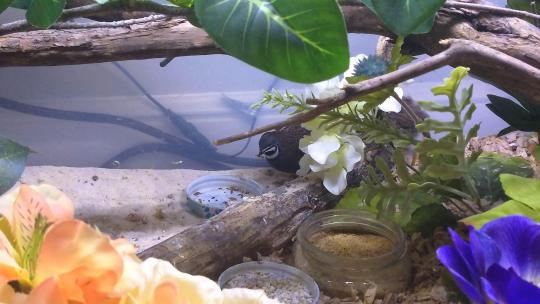
(Wasabi holding a One Singular bug for his wife to come take. He’s such a good husband and saves the best treats just for her. <3)
I attribute this to a mixture of changes, of course. It took a while to get this far and a LOT of adjustments, but it’s been worth it. I would say the greatest changes we made were...
- Keep general maintenance quick, calm, and Consistently reward door openings with treats. Scattered treats (ex. millet balls/individual seeds) are superior to entire millet sprays or dishes. ALWAYS remove birds from enclosure and place inside a dark, soft-sided box covered with a blanket for Safety during full cage cleans. GREATLY reduces stress associated with free-roaming.
- Multiple substrate types are better than one. Soft paper bedding or wood shavings are gentle on feet and aren’t super messy, and a corner of sand is greatly appreciated! They dust bathe several times a day and it seems to be a sort of ‘bonding’ time for them both. Rinsing sand vs. unrinsed soil is MUCH better for them as well, I learned that the hard way...everything was ridiculously dusty before and now we have had 0 dust problems!
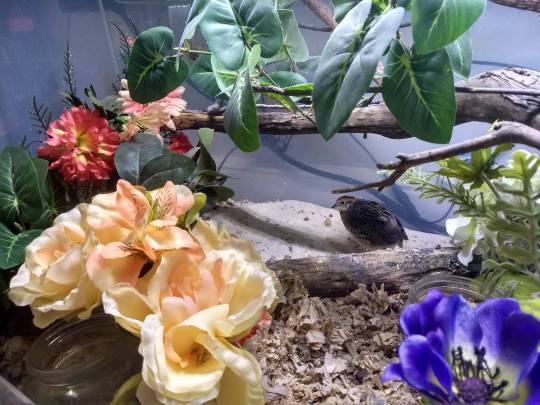
(Pardon her bald butt, Bibi is NEVER aggressive with her, but he still manages to rub off her feathers when they court and she looks pretty weird. I’m not sure how to prevent this.)
- Cover!! And LOADS of it!! Even if you think it’s enough, it isn’t. Visual barriers are so important and they THRIVE when they have decor they can hide under/behind and run between. They’re tiny birds and can dive around it like it’s nothing, and even though the enclosure looks crowded, it’s actually set up so they have Maximized floor space. GREATLY improves their confidence and sense of security. Switching up foliage/decor types seems to be beneficial, but large-scale, frequent changes probably aren’t the best. They seem to prefer when some decor is kept the same (ex. large wood features) and others are changed.
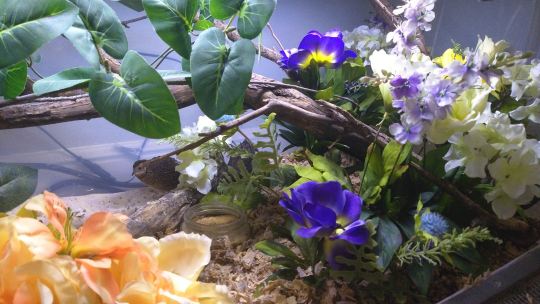
- Designing multiple “zones” seems to offer them a much greater amount of choice and has made a huge difference to their behavior. Instead of an enclosure where everything is the same, they now have a corner just for dust bathing/sleeping, a middle section with shaded water, and food in the open, and a third section with a lot of cover to the sides and an open middle area where they can be out of sight. Shown above, it looks impervious, but that’s all quail-accessible space behind that wall of decor. I plan on setting up an avian UVB light (but arcadia only makes them in T8s so I have to figure that out before I get one...) to put over their dust bathing/open area to give them further choice and basking options, as well.
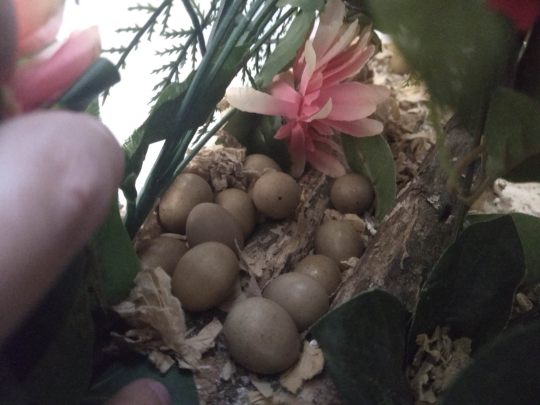
(Mushy’s secret egg stash!! I didn’t even know these were here until today, they’re so well hidden!! She never broods them, but it’s interesting to see that she’s started to lay them in the same place, she never did that before the changes.)
All in all, these little changes have added up, and I’m still improving as we go along. I have additional plans for building a larger enclosure for them one day (probably 48″x24″x12-18″) so they can have a third substrate option and even more room to run and roam...it shouldn’t be too expensive and I think they’d really enjoy it.
This turned into quite the ramble, but I hope it proves to someone out there that ENRICHMENT. MATTERS. And that just because your first run of something was ‘fine’ or even ‘good’ doesn’t mean it can’t be BETTER!! Learn from your mistakes, learn what you can improve, watch your animals and see what they do and how to encourage healthy, natural behaviors. Enrichment of all types isn’t just for our enjoyment, or because it looks pretty or cute. These changes have greatly influenced my birds’ behavior and comfort, and we will continue to learn and improve as time goes on.
It’s a never-ending process, and it’s a bit of work, but seeing them healthy, calm, and content is what all pet owners should strive for.
#birdblr#animal enrichment#avian enrichment#vivarium design#button quail#my pets#mushroom#wasabi#i have to send an update to the guy i adopted them from#to let him know theyre doing well#it was so funny when we met in that wawa parking lot so i could pick the birds up#i think we were both worried the other person was going to be a serial killer#or worse...some creepy old dude...#but nah it was a really rad trans guy and his girlfriend#and theyre my age and were all pretty short and just looked at each other like#'im so glad youre someone my age and also not a murderer'#and we talked for a while and they were very chill and passionate about birds#and i think theyd probably like to hear about how the quail are doing...#last time i showed them the enclosure they went out and got more stuff for their own quail#and made it all handsome and added lots of cover and branches and stuff for them#it made me so happy...they were so inspired by my own care that they improved their own birds c':#thats what its all about#thats why i ramble like this and want to keep animals all my life#it makes me so frickin happy
163 notes
·
View notes
Text
A lot of people(actually, most people) that I meet that find out about my animals will ask "How many do you have?" And when I answer "14 reptiles, 30+ rats, and 20+ mice, a tarantula, and a colony of roaches" I either get a "you're crazy" look or the question, "How do you take care of so many?" Which basically translates to "Are you a hoarder?" And the way I answer varies. But often times I have to explain exactly how and why I got all my animals. Explanation goes as such: I have acquired each and every one of my pets over the span of 6 years. I got them all slowly, not all at once so I could gauge how many I am able to take care of properly and without neglecting ANY of their wants or needs. If you asked me to name all of my animals, I could give you all of their names, if they are in shed or not, when they last ate, etc without even looking into the enclosures. I could tell you their age, their weight, and often times when their last shed was. Again, without looking at the paper work or enclosures. I was able to figure out my own limits of what I could handle by getting them slowly and surely, and letting the ones I had grow into adults before getting more. I set aside entire days dedicated to cleaning enclosures, taking photos, and assessing their health. Just today I spent a good 4 hours cleaning up the rat room, taking pictures of the reptiles, spot cleaning, sweeping, mopping, etc etc. And I ENJOY this process. A big part of owning animals is only get what you can take care of. You don't have to enjoy the cleaning process like I do, but you need to be able to do it without fail. Today I took out two FULL trash bags of soiled woodchips from the rodents I have. I often take out 3 or 4 full trash bags after cleaning out reptile enclosures. It is a ton of work and you HAVE to be willing to do it. That being said. My animals come before even myself. I worked six days in a row before today, and still set aside the entire day to clean and take care of everyone. The difference between a good keeper and a bad keeper is the willingness to know your limits, and actually abide by them. My animals all have what they need and more, they have things that 90% of other keepers would not provide because its not a 'necessity.' my high humidity snakes BOTH have waterfalls in their enclosures. My ball pythons have climbing enrichment. My hognose has 2 inches of substrate to dig in. My rats and mice, even though they are feeders, have running wheels, things to chew on, LARGE multi-story enclosures. The point is. You can have lots of animals and be able to take care of all of them properly, you just have to be willing to.
238 notes
·
View notes
Text
Change in Plans
I've known for a few months now that I would be moving and my new housing situation wouldn't allow all of my geckos, so I've been slowly selling off and rehoming lots of my geckos. I did think, however, that I would be allowed to bring my one smaller rack with ~15 geckos, but I've since been informed that they no longer feel comfortable with that and I will need to rehome these geckos before July. That being said, I have a lot of geckos who are very special to me who I now need to find suitable homes for. I have a couple of pet only geckos, along with breeding pairs for sale. Many of these geckos have been with me for a very long time, and some of these gecks were my first breeders, my first babies hatched, etc. I would love for these guys to go to good homes, so please let me know if you are interested. I have attached photos below and all asking prices are negotiable. Although this is far from ideal and very different from the original plan, my main concern is their health and happiness throughout this rehoming process. I have attached photos and information below, please feel free to contact me here or through [email protected]! Interested in buying a gecko?
BREEDERS
1.2 WY Bell Sunglow group (proven) - $325
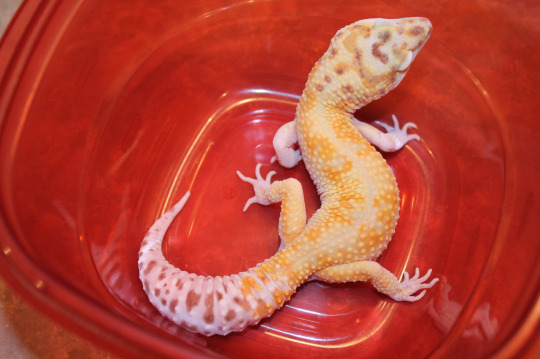
Solar - male WY Bell sunglow - $150
Notes: Solar is a very easy-going geck and a very gentle breeder, I never have to worry about him with the females. He loves his roaches and supers and just being a cute little couch potato! He is also very easy to handle! This whole group was definitely handled a lot from the original breeder (Lone Star Geckos) and it shows with their personalities!
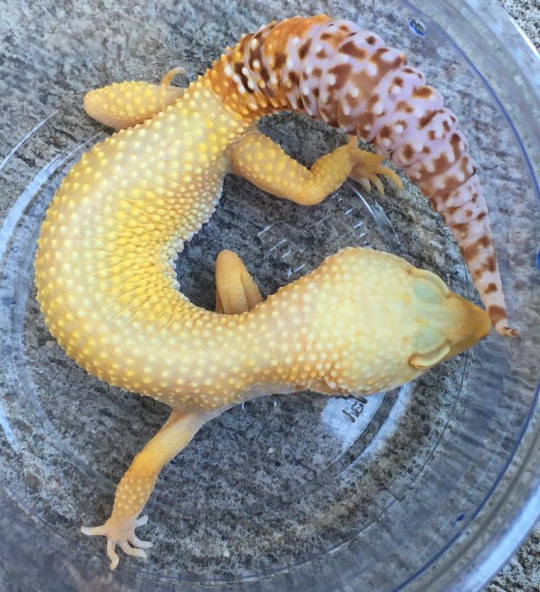
Portia - female bell sunglow - $125
Notes: Portia is an inquisitive gecko who can be a bit shy, but ultimately can be coaxed out of anywhere with food! She's a great eater and very handleable as well. This whole group was definitely handled a lot from the original breeder (Lone Star Geckos) and it shows with their personalities!
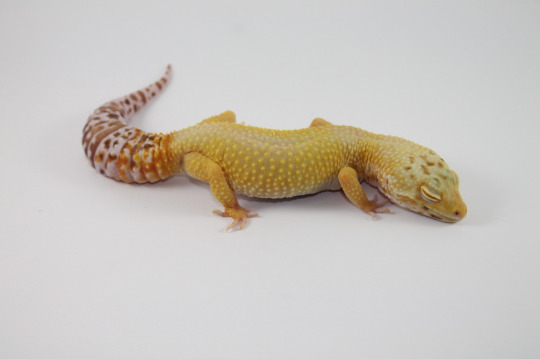
Titania - female bell sunglow - $125
Notes: Titania can ge to be a bit of a chunky girl, so I closely monitor her diet and how often she eats. She puts on weight incredibly easy, so I usually stick with smaller food items and larger bowls to keep her active and try to use lots of enrichment to encourage her to move around more! She is also very much a couch-potato (like Solar), making her very easy to handle. This whole group was definitely handled a lot from the original breeder (Lone Star Geckos) and it shows with their personalities!
1.1 Tremper sunglows (proven) - $150
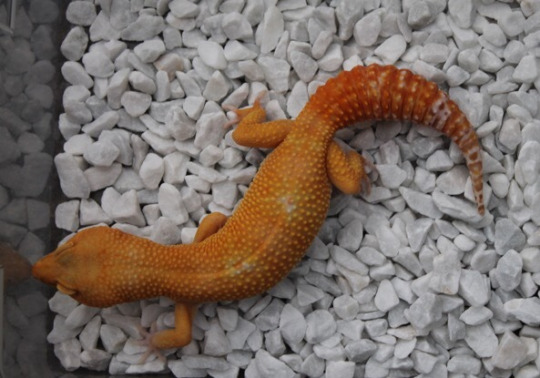
Chris - male Tremper sunglow - $125
Notes: Chris is a very muscular boy who loves to climb and is very food driven. I enjoy letting him hunt his food out and seeing how well he does and making it more of a game for him. He tolerates handling, but can be a bit squirmy. He's fathered gorgeous tremper sunglows who were very orange just like him!
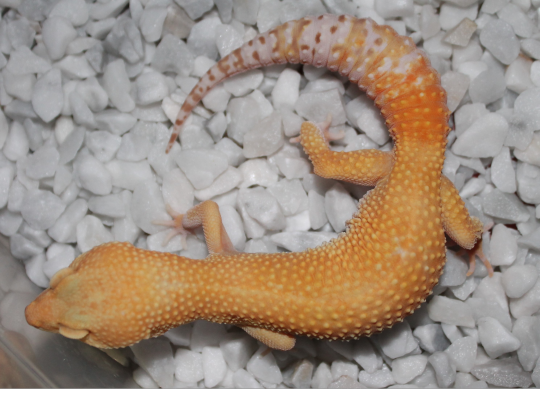
Cathy - female Tremper sunglow - $90
Notes: Cathy is a very long girl who loves to adventure, and she has quite a muscular build as well. She has had beautiful tremper sunglow babies with Chris who were all perfect and very colorful! She was a great breeder who held her weight extremely well and ate completely normally throughout the entire process. She does prefer to eat unbothered, though, and doesn't seem to enjoy handling, so I leave her to her own business.
1.1 WY Trempers RAPTOR pair (proven) - $250
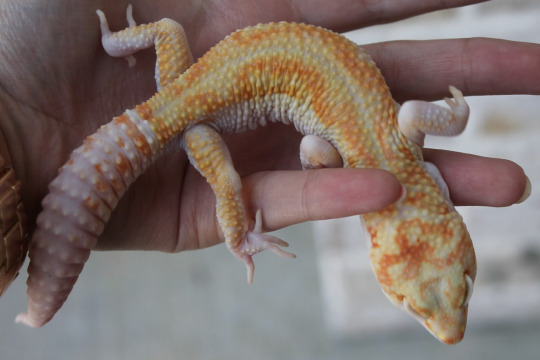
Alien -male WY Tremper het eclipse - $150
Notes: This is my sweetest boy, he is an absolute sweetheart who does incredibly well with handling, hand-feeding, and is super chill and docile. He is a great eater as well!
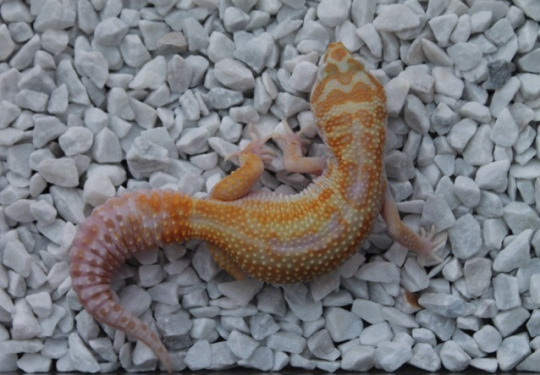
Comet - female WY Tremper het eclipse - $150
Notes: Comet is a gorgeous and prolific proven breeder. She is an extremely sweet and curious girl and has produced some beautiful offspring in her two years of breeding. She is a wonderful eater and tolerates handling very well! She can take breeding a bit rough in terms of weight loss, but does well when she is given access to food at all times during the breeding season.
1.1 Tangerine Tremper Eclipse pair - $150
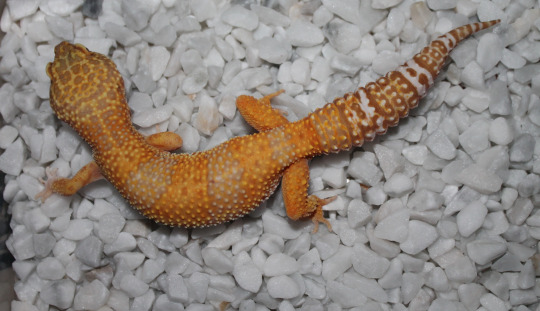
Reine - female "super tangelo" (high contrast tangerine tremper albino) ph Eclipse (proven)
Notes: Reine has been a bit of an oddball for me with breeding; she has ovulated, but I haven't successfully paired her with a male. However, I didn't try much these last two years and don't like to leave males in with females due to a past injury between two geckos, so I'm not sure about her breeding status. She did come as a proven breeder who produced many beautiful babies. She does fine with handling, though I tend to leave her to her own business.
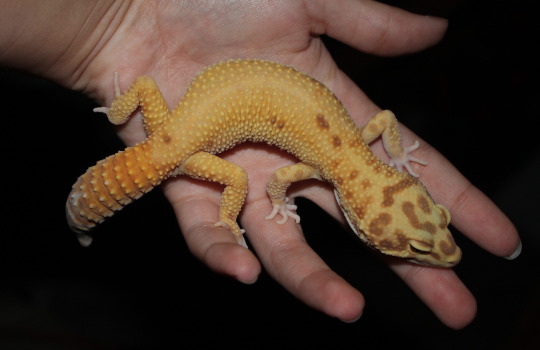
Snap Dragon - male APTOR ph Eclipse (proven)
Notes: Despite his name, Snap Dragon is an absolute sweetheart. He loves hiding in tight hides and he prefers to eat without being watched. He is a proven breeder and fathered some gorgeous babies as well :) This guy has dulled down over time, but he was extremely vibrant orange as a young one.
PET ONLY
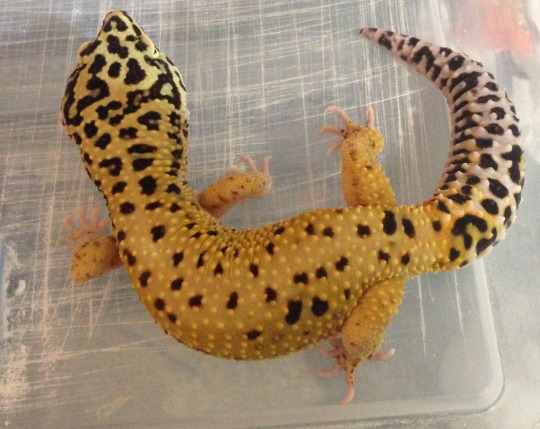
Cosmo - $50
Notes: Cosmo used to be one of my breeders, but had a prolapsed hemipene that required surgical amputation, hence my retirement of him as a breeder here. He is such a lovely giant boy, and I’ve taken him to many educational and school events. He does wonderful with handling and is just super sweet around everyone, and he was one of my very first geckos. He would make an amazing pet for anyone wanting an inquisitive, friendly, and easygoing gecko.
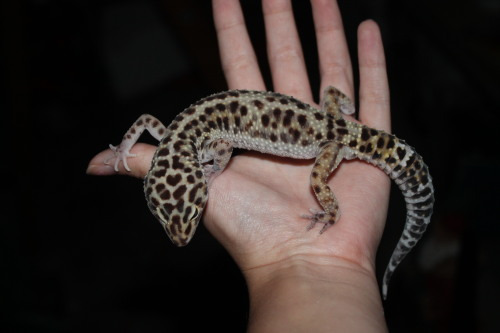
Sweet Pea - ON HOLD
Notes: We named this lil one “Sweet Pea” ironically, as he is a devil child to me. He absolutely loves my friends, but this gecko is definitely not the biggest fan of me. He is very sweet to others and loves tight hides and feeling secure. His moist hide is his favorite. I love his little heart on his head and he does have some neat coloring. He loves just sitting on hands (not mine, of course) and eating from tongs and chasing his food. He’s a muscular little dude who loves to climb and would do well in a habitat with a bit of vertical space (he used to hang from the top of the mesh lid of his tank). This dude definitely does not lack personality. He eats anything that moves. He’d be a lovely pet for someone and I really feel he’d do better in a home with someone he likes instead of tail waving at me every time I walk by, especially based on how different he is with everyone else. Sweet Pea is listed as pet only because he has produced two different geckos with neuro-like symptoms from two different females, so he could carry a neuro issue in his line.
#the celestial geckos#leopard geckos#lizards#for sale#available#animals available#available leopard geckos post#Lizards for Sale#tremper albino#Tremper Sunglow#bell albino#bell sunglow#white and yellow#w&y#wy#w/y#proven
63 notes
·
View notes
Note
Man I love you and your blog so much, especially when you talk about your 'pedes
In terms of enrichment, the best thing I say is to provide as much as a natural environment as you can. Bugs I don’t think really play or anything ,but they do have needs that must be met. Keeping a bug in a plastic container with no cover or substrate I find is rather cruel. Even with people with large collections give their animals substrate and a place to hide. How would you feel if you were kept in a small smooth box with nothing else in it? It wouldn’t be fun I tell you.
Communal insects like hissing roaches have been observed being ‘depressed’ when kept alone. Some insects like millipedes are happy to have tank-mates. Some however, prefer a solitary life, so it’s up to you to research and see!
Arthropods need to feel safe. Giving them plenty of places to hide will give them some piece of mind. You also should allow them to engage in natural behaviors. A millipede without soil to burrow into may become distressed or frustrated. A desert insect being stuck in a wet environment will not be happy. A tropical insect in a desert environment will be equally unhappy.
What I find are best are these things.
Places to hide and burrow. Natural soil/sand is good for this with enough space to allow digging. This can also include leaf and moss cover. Just in general, they appreciate having lots of cover.
Research. Don’t take desert animal like velvet ants and death feigning beetles and stick them in very wet tank. Don’t take a wet and cool loving creature, like a velvet worm, and put them in a tank that’s hot and dry. Keeping an insect happy and reduce stress is to closely create as natural of conditions that they would normally get in the wild.
Socialization. If your pet is a communal insect, give them at least two other buddies.
Climbing stuff. Things like branches, pieces of wood, even live vines are something some insects enjoy. They do explore so having lots of things to climb on will keep them busy and active.
Edibles. Wood eating insects appreciate having wood in their tanks. Leaf eaters like being able to nibble leaves when they please. Leaving something natural and edible in the tank that won’t mold up is a fantastic way to keep them happy.
TREATS. A varied diet is an interesting diet! Offering veggies and fruit once in a while will give them something different in their lives. For predators sometimes you can do something like offer a mealworm instead of crickets. Just little changes once in a while is nice.
‘Walkies’. I like to take my millies out on my bed and let them climb all over the place (with supervision). They like to go and investigate stuff to nibble. This is not applicable for some species, like centipedes. But if something can be safely handled it’s nice to let them walk around a bit.
Example: My millipede tank is a constant 80F and a 60-75% humidity rate. There are several millies in the same tank and they groom and interact with each other. Leaf litter and wood is provided as their natural diet. There is about 4-5 inches of substrate, which they have burrowed many chambers and tunnels into in the course of a year. They have springtails which eat their waste so that their tank is always clean. They are provided random pieces of fruit and vegetables to try. They do have a hide, but they have burrowed holes around it to hide, instead of just going inside the damn thing lol. Currently I don’t have any branches to climb on, as the tank is small. But once I upgrade they will be getting lots of climbing space.
Currently it’s not known if arthropods ‘think’ or just run on pure instinct. Some insects like bees and ants can plan and communicate with each other. But does that mean they can think abstractly? Who knows. Even if they cannot, it’s still important to treat them with as much care and respect that you would like to get.
Hope this helps :D

27 notes
·
View notes
Note
Do you know of any pets that would be easy to keep for someone with fibromyalgia? I know all pets require cleaning, enrichment, maintenance, etc but I really love animals and had to rehome mine last year since I couldn't consistently take care of them due to my illness. I've been thinking about a dog a lot, but I just don't know if I could handle all the exercise and training right now. But I really miss having pets. :(
I’m sorry you had to rehome your previous animals! :( That really sucks.
I will note that I do not have fibromyalgia & only know a little about it, so I’m working with the symptoms list I googled - the main symptoms being pain, fatigue, and mental fog.
Smaller animals are probably your best bet, I think. Invertebrates might be a good idea if you have any you take a liking to. Roaches, other beetles, millipedes, tarantulas, isopods, mantids…. all of them are popular pets. For most/all of these, you can set up a bioactive enclosure that is fairly easy to maintain - not removing/dumping/replacing a large amount of substrate each week or monthly. Enrichment is also fairly simple and most of it involves setting the enclosure up to give them room to choose their surroundings. Feeding is obviously still important, but can be pretty simple, which may be easier during brain fog & fatigue periods.
Likewise, you could also try smaller reptiles like small snakes (sand boas, rosy boas…I know there are more, but I’m blanking). Reptiles don’t typically care too much about handling, if you have a period of not being able to do so. You won’t need as big of a tank or as much substrate as larger snakes (like corn snakes & ball pythons), which may be more manageable. Crested geckos are another good possibility, especially given they have an appropriate commercial diet.
I’m hesitant to suggest fish given that water changes can be pretty involved & I know I struggle a lot with them. But if you think you could handle it, a 10g tank with a betta fish might also work.
If you really want to look into a dog, I would take your time & make sure you’re thinking everything through. But adopting a middle-aged/elderly dog from a shelter might be a possibility? Obviously you’ll need to find the right fit for you, but they are usually already trained, don’t often need as much exercise & management as a young dog/puppy, and a lot of older dogs just really need a retirement home where they can hang out & sleep. Just keep in mind medical issues, since older dogs are also more prone to those & vet bills could get pretty expensive.
A large part of managing illnesses + pets is coming up with coping methods. Schedules, notes, and alarms to help remind yourself on feeding & cleaning despite brain fog. Asking for help from friends/family when you’re having a bad period & need a little assistance. And there can be a fine line to balance this, but keeping an eye on yourself to make sure you’re providing appropriate care, but without guilting yourself into a deeper hole if you have to put off a whole-cage-clean for one or two days. Asking a friend to help check you on that can help a lot too.
(Hopefully this doesn’t sound like telling you how to manage your disability, not trying to do that! Just trying to suggest other things that might help with managing animal care, because I’ve had to do some of these things before myself.)
I know I have other followers who are disabled animal owners - does anyone else have more suggestions?
49 notes
·
View notes
Note
Can I ask what you do for enrichment? I have a number of things in the tank and handle her regularly but I still worry my baby doesnt have enough.
Hi there and thank you for this lovely question!
Enrichment can be something that rotates, and not a bunch of things that you ALWAYS have to have in the enclosure.
Some of the easiest/laziest ways I provide enrichment: - cup of dirt or moss that the snake can burrow into- safe, pesticide-free flowers, twigs, and/or herbs from my garden- cardboard toilet paper or paper towel rolls- shed from another healthy and parasite-free snake- lightweight foam cat ball toys that have been rubbed on something to impart them with a smell: usually feathers, sweet mint leaves, grass, or on my own hair/scalp
Some of the more labor-intensive things I have done:- drill a snake-sized hole in a paper box and stuff it with a different type of substrate- paper bag filled with a different substrate type or with pesticide-free grass clippings- use removable wood branch percheslike those for bird cages, and multiple drilled holes in the side of an enclosure, to move branches around on a side of the enclosure- drag a frozen/thaw prey item around the enclosure and hide it to simulate hunting- arrange “meet and greets” with two or more similarly-sized healthy snakes so that they can say hi for a short time on neutral ground- put feeder bugs in the enclosure for a few hours like super worms or dubia roaches, which are purchased as food for other pets but snakes can show a lot of interest in them for a short while. It’s a pain to dig all of the bugs out of the substrate, though, so make sure you know how many you’re putting in if you try it.
Remember that the key with enrichment is to give your animal the opportunity to engage in natural behaviors and use their brain. If your snake’s enclosure already has areas for climbing, digging, basking, hiding, and opportunities to stretch out completely, then she has 90% of what she needs and you can just swap out one or two “new” things for her to explore every week or so.Happy adventuring with your snakey pal!
#snake#snakes#answers to questions#text post#long post#reptile#reptiles#reptiblr#reptile enrichment#snake enrichment
96 notes
·
View notes
Text
Crested Gecko Care Sheet MasterList
I got my first reptile, a Crested Gecko named Atomic Tangerine Uzumaki, a few months back. I did a lot of research before adopting him and I decided to compile all my information in one place. Because I am new to reptile keeping some of this information could be inaccurate. If this is the case please let me know so I can correct myself I want to provide my gecko the best husbandry and do not want to spread misinformation. I’d like this guide to become a helpful resource for other keepers, but please do additional research if you are thinking about adopting a Crestie.
This Guide applies to Adult Crested Geckos information may vary for hatchlings and juveniles.
Crested Gecko Characteristics
Life Span: Approx. 15-20 years
Size: Mature Geckos reach approx. 8in. in length
Weight: Adults typically weigh 40-60 grams
Tail: Crested Geckos have the ability to drop their tails if stressed. After the tail is dropped Crested Geckos do not have the ability to regrow their tail. This has no effect on their health.
Coloration: Crested Geckos have a wide variety of colors (and some physical differences!) also known as “morphs” and is often a key factor in selecting a Crested Gecko, because of this wide range I will put additional information on this topic “here”
Gendering/Sexing: Once your Gecko reaches maturity in anywhere from 6 months to a year sexing your gecko can be somewhat simple. The easiest way to determine the gender of your Crestie is to look for a bulge at the base of the tail. This bulge should have a slight indent at the bottom and indicates a male Gecko. A female Gecko will lack this feature. The slightly more difficult yet more accurate way to sex a Crested Gecko is by looking for “pores” on the bottom of the Gecko. A video on this topic can be found “Here”
Feeding/Diet: Crested Geckos are rather simple reptiles to feed. They should be fed an approximate milk jug cap worth of specially formulated Crested Gecko food every couple of days (a powder mixed with water into a paste; even if the food is not replaced daily always have accessible food in the enclosure). Additionally, gut-loaded/calcium dusted insects (crickets, roaches, waxworms, mealworms, etc) can be offered on occasion. Cresties prefer to get their water from droplets on the plants and glass of their enclosure. Because of this, the tank should be misted 1-2 times daily. A small dish of water should also always be available.
Female Crested Geckos may stop eating for a short period of time before laying an egg, food should still be consistently offered. After laying an egg offering supplemental calcium-enriched foods may be beneficial to replace calcium used to create the egg(s). If the Gecko has not gone to the bathroom for two weeks or has lost a significant amount of weight your veterinarian should be contacted.
Handling Behavior: Crested Geckos tend to be friendly lizards that deal well with being handled. Even if the Gecko nips their teeth are so small and dull they do not hurt and are unlikely to draw blood. Crested Geckos like to climb so your gecko may climb you. Cresties also jump, for this reason, it’s important to be aware to prevent your gecko from falling too far and injuring itself. A video on proper handling can be found “here”.
General Behavior: Crested Geckos are an arboreal species meaning they like to spend time up high on branches surrounded by leaves. because of this these geckos are talented climbers and have specialized feet even allowing them to stick to glass. In addition, Cresties are a nocturnal species. Because of this they often spend the days sleeping up high and becoming active at night.
Crested Gecko Housing
Terrarium Size: A single adult Crested Gecko requires a minimum of 20gal of space. If keeping more than one gecko in the same enclosure an additional 5-10 gallons is recommended for each additional gecko. due to their arboreal nature, the terrarium should be taller than it is wide to allow for climbing (EX: 16L*16W*25H). This enclosure should also ideally have a mesh lid to prevent the enclosure from becoming too humid.
Housing temperature: Crested Geckos will prefer temperatures of 72-75 degrees Fahrenheit (22.22-23.33 Celsius) tending to be more sensitive to temperatures that are too high so it is important to not exceed the maximum 82 degrees. At night temperatures can drop to 65-70 degrees Fahrenheit (18-21 Celsius).
Preferred Humidity: The humidity of a Crested Geckos enclosure will vary throughout the day due to misting to ensure the gecko has a source of water, however, too much constant humidity can also present a health risk for Cresties. The base humidity for your Crestie should be about 50 percent getting up to as high as 80 percent directly after their enclosure is misted
Lighting: While Crested Geckos can do well with ambient lighting some research has indicated that UVB light may be beneficial for Cresties. additionally, lighting may also help with keeping the enclosure at a consistent temperature. Be careful not to overheat your Geckos or use bulbs at night that will disrupt their nocturnal cycle.
Decor/Supplies: Crested Geckos are arboreal species meaning they should have plenty of branches to climb within their enclosure in addition to space to jump. Additionally, your Crestie should have at least one hide in their enclosure allowing them to hide away from lights or people if they choose to do so. Finally, your take should have a humidity meter along with 1-2 thermometers to monitor the status of their enclosure to ensure it is the ideal environment for them.
Cohabitation: Crested Geckos may be housed together, but not all geckos may make a good pair. It should also be noted that geckos kept in groups of 2+ are more likely to drop their tails and suffer an injury due to possible fights. If you plan to keep more 2+ geckos in one enclosure please have a plan on how to house them separately if they begin to fight with one another.
Male/Male Enclosure: Two male Geckos housed together WILL NOT WORK male geckos will fight and injure or even kill one another.
Female/Female Enclosure: Two female geckos may work, the success of a F/F pair will be up to the personality of the Geckos being housed.
Female/Male Enclosure: A male and a female pair may also work but will come with unique challenges. this pair will need to be watched more closely because they will mate and may produce viable eggs. in addition, the male will need to be monitored to ensure he isn’t getting too aggressive with his female partner.
Additional Information: Crested Geckos can either be kept in a more standard enclosure “here” or a bioactive vivarium found “here”
Crested Gecko Health
Healthy Crested Geckos: Before you adopt your Gecko or after a Gecko is shipped to you visual examinations should be performed to ensure the Crestie is in good health. A healthy Crested Gecko should first and foremost be alert and respond to stimulation such as being picked up. The Cresties body should also be free of parasites and clear of any cuts, scrapes, lesions, and other injuries. Crested Geckos often shed their skin as well so the gecko should be checked for any sign of a stuck shed as a stuck shed can lead to health problems if left for a long period of time. Finally, the body condition needs to be taken into account as well. Cresties should not have any appearance of protruding pelvic bones in addition to a more rounded upper body. A responsible breeder should be able to give history on the gecko so be sure to ask about any previous health issues the Gecko may have dealt with.
Crested Geckos and Calcium: Crested Geckos have ‘Calcium Sacs’ in the back of their mouth that help indicate how much calcium your gecko is getting. These Calcium Sacs help indicate the calcium levels of your Gecko. If you suspect your Gecko may be low on calcium (such as after laying an egg) these sacs can be checked (how-to video here). These sacs should be round and white if they appear sunken and grey calcium should be supplemented in your Geckos diet. a video on the subject can be found “here”.
How To Keep Your Crested Gecko Healthy: One of the most important factors in keeping your Crested Gecko healthy is good husbandry. Keeping your Cresties enclosure at the right temperature and humidity along with feeding a proper diet can help lessen your Geckos chances for developing many illnesses. Many keepers also keep records on their Crestie in order to notice when possible issues arise. Keeping a weekly written record on your Geckos weight, feeding behavior, and shedding pattern is advised.
What Are Some Possible Diseases/Disorders Of Crested Geckos: This is a rather extensive topic so if you’d like to learn more “here” is a good place to start
When To Contact The Vet: If you ever have any fears about your Cresties Health its always better to be safe rather than sorry and contact your vet. A vet should always be contacted in the event of:
Rapid weight loss
Broken bones, deep cuts, and burns
Bloody stool or prolapse
Suspected choking, seizures, drowning, smoke inhalation, or poisoning
Prolonged/extreme lack of balance or walking in circles
Additional Info: Veterinary care is very important when owning any type of pet, they will rely on you to take care of them at every turn in their lives. Before adopting any type of animal you should have enough money put away to cover basic veterinary costs (wellness checks, vaccinations, antibiotics, etc.). Additionally, putting away additional money over time is advised in order to prepare for any unforeseen medical emergencies. Pet insurance is also something that may be beneficial to some pet owners and is worth consideration.
Again, this guide is meant as an introduction into Crested Geckos. Please do your own additional research if you plan on adopting a Crested Gecko.
Sources: X X X X X X X X X X X X X X X X X X X
0 notes
Photo
Thanks! She’s about 450 grams and maybe 2 to 2.5 feet long, it’s hard to say since she hardly ever stretches out for me.
Absolutely! My leopard gecko Bree was my first reptile and I think they are an amazing beginner animal. They are also very budget friendly, especially if you breed your own mealworms and roaches. I think my biggest concerns with new owners would be to really stress the importance of supplementation, humid hides, and where you get your Leo.
I have heard too many times that people just don’t dust their leopard geckos diet with calcium with D3 because the gecko “doesn’t like the taste”. Calcium with D3 isn’t optional! I see a lot of Leo’s with twisted limbs because they developed metabolic bone disease (mbd) from not having the proper amounts of vitamins and minerals in their diet. I use the repashy calcium plus myself, and I learned recently keeping it in the fridge helps it stay potent even longer.
Humid hides, man I have seen so many geckos with missing toes or even no toes at all! Providing your gecko with a little humid hide while they are in shed is so simple, a tupper ware with a hole in it and some paper towel is all you need! You can also get fancy ones and use moss, soil mixes, and vermiculite for enrichment. Just remember to mist it every so often and not have the substrate be too loose if you have a young gecko or lots of loose bugs running around. Don’t want them to take a chomp of substrate!
Lastly would be where you get your geck. I did all the research in the world on how to care for a leo, but honestly near nothing at all on reptile breeders. I just went to a local expo, found the one that spoke to me and took her home. Later I learned that this particular breeder is a very large scale breeder and I’ve heard multiple accounts of people getting animals from them and having them die shortly after. Bree was also about a year old when I got her and she was probably raised in a very small bin with no handling so she has a major attitude problem. Thankfully no health issues yet though. Had I known sooner I would’ve definitely looked at small scale local breeders first. Also please don’t get your Leo or any animal from a big name pet store like petco or petsmart. They are not healthy animals 90% of the time and a rescue is not a rescue if you pay for the animal it’s only supporting the business.
Edit: ALSO get a thermostat!! Highly recommend these for your heat mat! I had my leo’s heat go up to 125-130 without a thermostat during the summer! I’ve been using a cheap little jump start one and it’s been going strong and steady for nearly a year.
Oh and of course no cohabitating and no sand, I can go into this further if you’d like, but I just see this as a given and hopefully most people should know this by now. I rambled a bit there but I hope i helped and let me know if you want any more help! Send me pics of the leo if you do decide on getting one ☺️


My ball python setup! I have my girl in a 20 gallon long with a ceramic heat emitter, heat cable, reptichip substrate, a hide, 2 cork rounds, some rocks and leaf litter for enrichment too. Her temps are usually 82-86 on the hot side ambient and 78-82 for the cool side. Never missed a meal! The the light is only for the photo and when I want to peak at her, it’s not part of the actual setup and was stolen from my bettas tanks. Let me know what y’all think and feel free to show off your setups/ask for advice! I work for a reptile pet store so I know a thing or two :)
68 notes
·
View notes
Text
Updates
Well.
It’s my 21st birthday today.
I’ve been very quiet here since winter, but in actuality so much has happened. I’m still sorry for being-here but not-being-here, and vanishing on everyone waiting on art, but it’s really been a whirlwind. Just a real wild ride.
I had this big, rambling post written up, explaining what’s happened so far this year and what’s been going on, but I don’t think it’s necessary really. What matters is that I’ve made it this far. This time six months ago I really wasn’t sure if I’d make it to see today. But. Here I am.
I feel like life has been pretty unrelenting in the past few years, and it never seems to end. Between this post and my last text posts, I’ve had another Break Down due to problems with work and doctors, and it’s been pretty terrifying, but I think it’s going to be okay. We’re not out of the woods and I really need to focus on this right now so I still won’t have time to get back into art (which I do plan on doing!! But it’s really not fair to anyone for me to start up again when I’m still not completely stable) and everything else.
But hey. Even after that recent disaster, I’m still here. I’ve been on much better meds for almost 5 months now, I’ve been figuring out what I want to do with my life, and I have my second wind. Things have been getting a lot better (even though a LOT has also been going wrong, but such is life, and we get through it!) and I’ve been on the right track for several months now. I think I’m truly happy.
I’m still here and so is most everyone else. I figure it’s about time I do an update on everyone, as this is a pet blog after all, and I think it’s best to let everyone know how we’re all doing. It’s been a long time since I really talked about everyone properly, and a lot has happened. So here’s the all-encompassing update on everyone:
INVERTS
I posted about this a bit before, but yes. At the start of July I found that I lost about half of the tarantulas. While I think in general we were doing okay picking up the pieces from everything that happened, not everyone was alright. It’s my fault, and I take responsibility. I don’t care how tough things were, it wasn’t fair to them that I let them go unnoticed for too long. Most of the slings passed away, they got too dry, and the more moisture dependent ones passed away as well, including Boopus, Conte, Lucy, and Cassini.
There is a huge hole in my heart from losing them. I will never let this happen again. I don’t CARE how hard things get for me, I will NEVER let my illness take the lives of the ones I care about ever again. I don’t know if it’s the right decision to continue keeping Ts at all after what happened, but since it did, Jessie and I had a very serious conversation about was has to change if I want to keep the remaining Ts. I’ve spent a lot of time re-working how I care for everyone, and so far, everyone has been recovering VERY well. The remaining Ts are: Agnes, Deckard, Isidore, Montag, Winnipeg, Wilder, Flaveri, Kessler, Kitty, and Turnip. They are all fat and hydrated and doing better. Deckard and Isidore molted successfully, and Winnipeg is deep in pre-molt. Montag had some sort of weird kinda-mites-but-not-mites thing going on, but I got most of them off and they’ve been doing really well for about a month now.
Suffice to say I think everyone is going to be okay. The ones that are here. I do love them deeply and I need to not let my illness get in the way of them. My depression was slowly eating away at everything I loved, including them and my desire and ability to care for them, but I will never let it happen again. No matter what, I’ll do what’s best for them, even if it’s a tough decision.
As for the other inverts...the roaches are all doing very well. Red goblins have had their ups and downs but the colony is big and thriving. I finally have adults again and babies are cropping up once more. My dubia colony is finally stable and they’ve been delightful waste disposals for all the ugly peppers and bolted greens from our poor little garden. The rothi, the Original Dig Sons, are STILL kicking. I thought the female was gone but she cropped up again and is as gigantic and cute as ever. They’re chubby and happy and digging like champs. The little kenyans are also doing well!! I’m moving them in with the dubia and they seem to thrive with them. Everyone is peaceful and passive to one another, and by being in the bigger colony they have much more space and food options than before.
All in all, the inverts are recovering and doing okay. I also have thriving isopod cultures in the geckos’ vivs, and they’re doing very well! Lots of orange P. pruinosis in there.
REPTILES
Vladimir and Estragon are doing WONDERFULLY. After the fire I was very worried about the smoke, but both geckos have been perfectly fine and very active and healthy, especially as the weathers warmed up. Estragon is exploring all the time now, and has recovered well after all the stress of moving around so much earlier this year. As I type this he’s climbing the glass of his viv and mleming the air. He’s such a little man and I love him. I’ve been watering the vivariums properly again and they’ve been exploding with growth! Not all the plants made it but the ones left actually need trimming, they’re growing too fast!! The local pet place has lots of vivarium plants available actually and I got a couple that I’m going to plant in the empty spots for the boys. So right now the vivs definitely look a little wonky, but it’s nothing we can’t fix, and the boys themselves are doing GREAT. They lost a little weight after all the chaos, but Gogo is a good chunky boy and Didi is doing awesome too!! Eating lots and he even catches the loose roaches that have been living in the leaf litter, which is pretty cool to watch and great enrichment for him. My little men have been doing so good and I’m so happy that we’re all okay. <3
MAMMALS
Before the fire, I had recently gotten my very first rats, which was a huge deal on here, if any of you remember that!! Java, Lisp, and Python have been thankfully 100% okay after the fire, and have suffered 0 smoke injury! They were farther from where it happened, but there was definitely some smell in my room but now, eight months later, I think it’s safe to say that they’re unaffected. The rats are doing GREAT. They get pampered every single day by everyone here, and my roommate LOVES them. Even when I couldn’t take care of them, he’d feed them and squish them daily, which was a huge help while I dealt with all the craziness. I’m getting back into the routine and taking over their care again, but I can’t thank him enough for his help.
The rats are now THE BIGGEST BOYS and Java is the BEST bean!!! He went from peeping and running away when we first got him to bruxing like CRAZY whenever we hold him and he loves being squished. I don’t know why. They all just love being held and squished and Lisp has some really unsettling Extreme Happy Boggles when we do it, he loves being crushed. (Not that we actually “crush” them, just gently pretend to squish them with our hands while joking about squashing them into pancakes)
They get so much love every single day, and they’ve been one of the best things to ever happen to us. Unfortunately since moving here (and I wasn’t aware of this until the day of move-in, haha, lucky me...) they’ve had to live in the basement which is colder than I’d like and makes it hard for me to care for them, but soon we’re switching to 100% fleece and they’ll be able to live up here with us properly!! I’m so excited about it and it’ll make caring for them so much easier. I’m so excited.
OH and how could I forget. I put off saying this but we DO have a few more pet friends since I last mentioned everyone in December. We bought five little mice into our home many months ago, and their names are Awesome Opossom, Moggles the Mole, Inspector Beans, Bhombus, and Trungalo. They were one of the best things ever, for me. They’re the perfect fit for our lives and they’ve been thriving since we got them. They’re so relaxing and wonderful, and they are incredibly calm and squishy little girls. Sadly, Possie passed away a month or so after she came here (she was almost like a FTT...she was doing so well, then she just...she wasn’t growing like everyone else, no matter what I did, and one day she just. Didn’t make it. We found her snuggled up in her favorite hide in a pile of fleece. No one bothered her. She passed away peacefully.) and she just...she was here for such a short time but she changed everyone’s lives forever. She was the most incredible little thing. She was so outgoing and sweet and when we bought them home she instantly became Nick’s favorite little friend. I’d come home from work and he’d be in the middle of the living room playing with her. He loved her so, so much and even though the mice “are mine” I really think Possie was his. She was a very special little thing and I’m glad she could spend the last of her time with us. She was an incredible little animal.
All in all though...the rodents are doing good. It still hurts my heart that Possie passed away but we did everything we could and we had a special little service for her under the big tree in the backyard, and we will never forget her. I kinda wish everyone here could’ve gotten to know her too. She was really something special.
Otherwise...ahh gosh it feels really sad to say anything else after talking about Possie. She was so, so wonderful, but so are the remaining meecers. Mice are weird. They’re just so small and gentle and wonderful, and I’m really happy to have them with us.
Oh yes!! And there are two more little friends who joined us. I researched getting birds for a few years, and back in mid-April in my area there was a couple having to rehome some of their button quail. They hatched and raised them by hand, and I talked it through with Jessie and we jumped on the opportunity to adopt a pair. It worked out wonderfully for everyone and now it’s been about four months with us and they’re doing fantastic. Their names are Wasabi (male) and Mushroom (female) and they’re an extremely devoted mated pair and we love them. They’re in our front living room and while we don’t/can’t handle them they have become so outgoing in their own way and I’ve learned so much about caring for them over the past few months. They’re very relaxing to care for and any time I slack a bit with anything, they let me know by tapping the front of the enclosure until I investigate and fix whatever’s wrong. It’s actually really helpful and over time I’ve gotten much better and now they hardly ever pace or tap the front, which makes me feel like I’m doing something right. They seem peaceful and spend a lot of their time with each other and bathing in their dirt bath or foraging for treats. c:
All in all, we’re really getting there and have been getting so much better since The Disaster that was winter. The animals are doing great/much better, I’m getting better (although the recent scare is still a drain and I do have to work 12-9 pm today but so it goes...) and it’s going to be alright, I think. And I have a very supportive partner and awesome roommate and friends and I can’t thank them enough for helping me get this far. I wouldn’t be here without them.
Well anyway. Happy birthday to me, I spent way too long writing this and now I need to rush to get ready to work for the rest of the day/night. But so it goes, I’ve been through worse. c;
#update#personal#animal update#my pets#i gotta post pictures sometime of everyone#just a bit embarassed cause the vivs look kinda ugly right now#some plants are gangly and others are growing like weeds and it doesnt look very professional#and the rats are unfortunately in the basement right now which doesnt look very nice...#i hate having them down there and its made everything a lot harder but soon theyll be up here again and itll be a lot easier#and better for everyone#also bless nick for being so awesome and helping with them#he really loves the rats and on the days im working until 9 pm hes a huge help#he feeds them and gives them pets and picks them up every day#and soon when theyre up here itll be even easier to just. Pick Up a rat and hang out with them#itll be good#ohh and i gotta show everyone the meecers#theyre SO GOOD such good friends#theyre all angora and suuuuper soft and wonderful#theyre really entertaining and calming to play with and take care of#i love the rats and i love the mice and i love the geckos and the quail and the Ts and the roaches#BUT NO MORE PETS FOR A WHILE.#HOO.#im VERY HAPPY with my limit right now and i dont want to go beyond this until like. im 1000% stable and good for a while!!!#anyway wow i ramble a lot#happy birthday to me#long post#text post
2 notes
·
View notes
Note
For my masters project, I wrote a book for teachers about proper care of class pets. I'm thinking of revisiting it in hopes of getting it published, and am working on updating its info. What small animals do you feel are best suited to school life - assuming that the teacher is a proper caretaker (and as a teacher, I know that assumes a great deal - that's what the point of the book is, that teachers who choose to have class pets are obligated to model proper caretaking for the students).
Gah, I find this really hard because I really just…don’t believe in classroom pets. :-/ I’ve had very bad experiences with it personally, and I rarely hear GOOD stories about classroom pets. So the whole thing just seems like a horrible idea to me.
That said…I guess these are the ones I would suggest if the teacher is really willing to put the effort in and make it work out for the animal, not just the classroom & kids, along with my reasoning.
- Invertebrates: I saw a post discussing this recently…I can’t recall if I reblogged it or not. If I remember, I’ll try to find it. There’s a fair number of invertebrates with pretty easy diets, not a lot of special temperature/humidity needs, can be kept in small tanks (5-10g) & are big enough to be interesting to watch. Also generally pretty cheap to buy, set up, & maintain. Bonus of teaching kids the interesting parts of bugs, their important role in various ecosystems, etc. Examples include roaches, other beetles, preying mantids, isopods…I’m sure I’m forgetting some.
- Mice: NOT to be hands-on for the kids; can keep a couple females together in a small enough tank to be reasonable for classroom - 20-30g; don’t need particularly special temperature/humidity; relatively easy diet to manage in classroom setting.
- Gerbils: Also not to be hands-on for kids; again, can keep a pair of same sex gerbils in a similar sized tank as mouse; also a relatively easy diet, no special temp/humidity needs. They do need plenty of digging space & care must be taken with enrichment because they’ll chew it.
These are really the only mammals I’m comfortable even suggesting. I’m still hesitant because both are prey animals that can be easily stressed by noise, so I would consider it necessary for the teacher to watch behavior & health and be willing to remove the animals to their own home if the noise & activity prove to be too stressful. I’m not comfortable listing any other mammals - most need much more space than most classrooms are willing or able to provide, or they need more hands-on socializing, or they have more specific care needs that could get tricky.
- Crested gecko: Similar to above, this is the only reptile I think I’m comfortable with suggesting. I’m not as great on reptiles, so there might be some other potential options. But most reptiles need special heating, lighting, need live prey or frozen rodents for prey, etc. All of that gets a lot more dicey in a classroom setting where heating elements may not be allowed or may get turned off by cleaning staff. Crested geckos don’t really need special heating/lighting (but care does need to be taken that they don’t get too warm, some classrooms can have issues with that), they can be fed a balanced commercial diet that’s easy to prepare, they can be kept in a relatively small tank, they’re fun to watch.
…That’s all I got. Fish can be more difficult to move since the tank must be drained, it would likely be harder to do water changes in most classrooms, etc. Otherwise I’d suggest possibly a betta fish in a 10g tank. But ehhhhh. Birds are an absolute no, hermit crabs require too elaborate of a set up to really be ideal in a classroom (and are not easy to dismantle for taking home on school breaks).
I’m sorry, I’m not sure how helpful this was! There just aren’t a lot of animals that really are reasonable to have in a classroom setting for the vast majority of classrooms & teachers. If a teacher is very dedicated & has permission from their superiors, they could check into curriculum-based programs that some places run - I remember my Fisheries & Wildlife courses discussing a fish program of some kind. I know sometimes there are programs with chicks in more rural areas, but I’m also rather skeptical of how good those are - it just depends on who the chicks go home with & the care they get. I’m guessing most just turn into farm hens, but still.
Another potential alternative idea you could include is doing classroom indoor or outdoor (if possible) gardens. Plants generally need less care, but it’d still be a decent lesson in care and could integrate well with a number of science & environment lessons.
#petblr#reptiblr#classroom pets#asks#comicbookmama#if anyone disagrees with my suggestions please feel free to speak up#or if you have good alternatives and reasoning on why#man I just really don't like classroom pets
111 notes
·
View notes